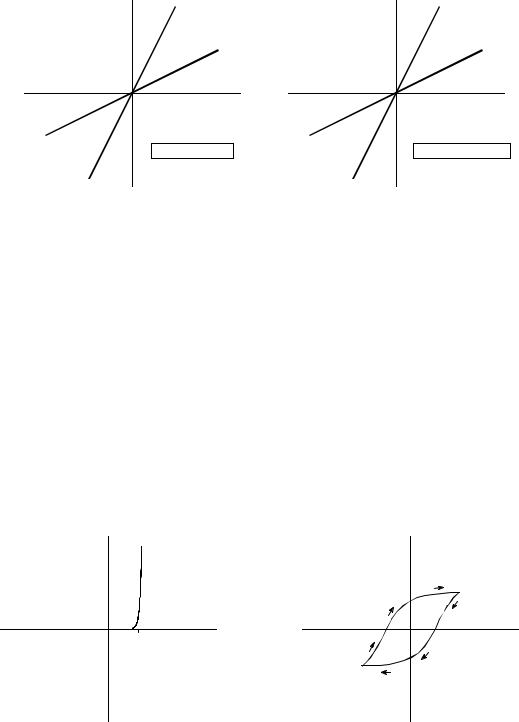
- •Signals and Systems
- •Requirements for Linearity
- •Static Linearity and Sinusoidal Fidelity
- •Examples of Linear and Nonlinear Systems
- •Examples of Linear Systems
- •Examples of Nonlinear Systems
- •Special Properties of Linearity
- •Superposition: the Foundation of DSP
- •Common Decompositions
- •Impulse Decomposition
- •Step Decomposition
- •Even/Odd Decomposition
- •Interlaced Decomposition
- •Fourier Decomposition
- •Alternatives to Linearity
92 |
The Scientist and Engineer's Guide to Digital Signal Processing |
Shift invariance is important because it means the characteristics of the system do not change with time (or whatever the independent variable happens to be). If a blip in the input causes a blop in the output, you can be assured that another blip will cause an identical blop. Most of the systems you encounter will be shift invariant. This is fortunate, because it is difficult to deal with systems that change their characteristics while in operation. For example, imagine that you have designed a digital filter to compensate for the degrading effects of a telephone transmission line. Your filter makes the voices sound more natural and easier to understand. Much to your surprise, along comes winter and you find the characteristics of the telephone line have changed with temperature. Your compensation filter is now mismatched and doesn't work especially well. This situation may require a more sophisticated algorithm that can a d a p t to changing conditions.
Why do homogeneity and additivity play a critical role in linearity, while shift invariance is something on the side? This is because linearity is a very broad concept, encompassing much more than just signals and systems. For example, consider a farmer selling oranges for $2 per crate and apples for $5 per crate. If the farmer sells only oranges, he will receive $20 for 10 crates, and $40 for 20 crates, making the exchange homogenous. If he sells 20 crates of oranges and 10 crates of apples, the farmer will receive: 20 × $2 % 10 × $5 ' $90 . This is the same amount as if the two had been sold individually, making the transaction additive. Being both homogenous and additive, this sale of goods is a linear process. However, since there are no signals involved, this is not a system, and shift invariance has no meaning. Shift invariance can be thought of as an additional aspect of linearity needed when signals and systems are involved.
Static Linearity and Sinusoidal Fidelity
Homogeneity, additivity, and shift invariance are important because they provide the mathematical basis for defining linear systems. Unfortunately, these properties alone don't provide most scientists and engineers with an intuitive feeling of what linear systems are about. The properties of static linearity and sinusoidal fidelity are often of help here. These are not especially important from a mathematical standpoint, but relate to how humans think about and understand linear systems. You should pay special attention to this section.
Static linearity defines how a linear system reacts when the signals aren't changing, i.e., when they are DC or static. The static response of a linear system is very simple: the output is the input multiplied by a constant. That is, a graph of the possible input values plotted against the corresponding output values is a straight line that passes through the origin. This is shown in Fig. 5-5 for two common linear systems: Ohm's law for resistors, and Hooke's law for springs. For comparison, Fig. 5-6 shows the static relationship for two nonlinear systems: a pn junction diode, and the magnetic properties of iron.

Chapter 5- Linear Systems |
93 |
Current |
low |
resistance |
|
|
|
|
high |
|
resistance |
|
Voltage |
|
a. Ohm's law |
Elongation |
weak |
|
spring |
||
strong |
||
|
||
|
spring |
|
|
Force |
|
|
b. Hooke's law |
FIGURE 5-5
Two examples of static linearity. In (a), Ohm's law: the current through a resistor is equal to the voltage across the resistor divided by the resistance. In (b), Hooke's law: The elongation of a spring is equal to the applied force multiplied by the spring stiffness coefficient.
All linear systems have the property of static linearity. The opposite is usually true, but not always. There are systems that show static linearity, but are not linear with respect to changing signals. However, a very common class of systems can be completely understood with static linearity alone. In these systems it doesn't matter if the input signal is static or changing. These are called memoryless systems, because the output depends only on the present state of the input, and not on its history. For example, the instantaneous current in a resistor depends only on the instantaneous voltage across it, and not on how the signals came to be the value they are. If a system has static linearity, and is memoryless, then the system must be linear. This provides an important way to understand (and prove) the linearity of these simple systems.
Current |
B |
0.6 v Voltage |
B |
a. Silicon diode |
|
b. Iron |
FIGURE 5-6
Two examples of DC nonlinearity. In (a), a silicon diode has an exponential relationship between voltage and current. In (b), the relationship between magnetic intensity, H, and flux density, B, in iron depends on the history of the sample, a behavior called hysteresis.
